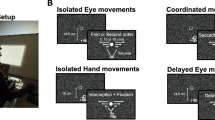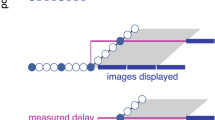Abstract
Past research has demonstrated that both peripheral and central vision play an important role in the control of movement direction. However, it has been unclear whether the benefits of these sources of information are due to adjustments in the limb trajectory during movement execution (i.e., online) or modification in motor commands prior to movement initiation (i.e., offline). In the present paper, we analyzed the variability in limb trajectories in a directional aiming task to examine the relative contributions of peripheral and central vision in both the planning and execution of movements. The point of gaze was manipulated to vary where in the limb trajectory information was gained from central and peripheral vision. Analysis of the variability in directional error at various stages of the movement revealed that participants utilized information from early in the trajectory during movement execution when it appeared in both peripheral and central visual fields. Information from late in the trajectory was used offline to improve the programming of subsequent movements regardless of where this information was available in the visual field.






Similar content being viewed by others
Notes
The p-values for the Longitudinal Distance main effects should be treated with some caution as it can be argued that the data are not independent.
The assumption was that if the variability profile for the no vision condition can be expressed as f(x) and the profile for another vision condition as af(x), then the two variability profiles have the same form. Variability ratios were calculated for each participant and submitted to an analysis of variance.
Fischer Z transforms were performed since correlation coefficients are not normally distributed.
Bédard and Proteau (2003) have inferred offline control from linear variability profiles. However, they did not analyze the ratios in variability or correlations in error.
A 2 Experiment × 4 Visual Conditions ANOVA revealed that directional variability at the target was greater in Experiment 2 compared with Experiment 1 in all visual conditions, F (1,30)=7.8, p<.01.
We thank an anonymous reviewer for this suggestion.
References
Abahnini K, Proteau L (1999) The role of peripheral and central visual information for the directional control of manual movements. Can J Exp Psychol 53:160–175
Abahnini K, Proteau L, Temprado JJ (1997) Evidence supporting the importance of peripheral visual information for the directional control of aiming movement. J Motor Behav 29:230–242
Abrams RA, Meyer DE, Kornblum S (1990) Eye-hand coordination: oculomotor control in rapid aimed limb movements. J Exp Psychol Hum Percept Perform 16:248–267
Bard C, Hay L, Fleury M (1985) Role of peripheral vision in the directional control of rapid aiming movements. Can J Exp Psychol 39:151–161
Bard C, Paillard J, Fleury M, Hay L, Larue J (1990) Positional versus directional control loops in visuomotor pointing. Europ Bull Cog Psychol 39:151–161
Bédard P, Proteau L (2003) On the role of peripheral visual afferent information for the control of rapid video-aiming movements. Acta Psychol 113:99–117
Blouin J, Bard C, Teasdale N, Fleury M (1993) On-line versus off-line control of rapid aiming movements. J Motor Behav 25:275–279
Bock O (1986) Contribution of retinal versus extraretinal signals towards visual localization in goal directed movements. Exp Brain Res 64:476–482
Brenner E, Smeets JBJ (2003) Fast corrections of movements with a computer mouse. Spatial Vis 16:365–376
Carlton LG (1981) Processing visual feedback information for movement control. J Exp Psychol Hum Percept Perform 7:1019–1032
Carlton LG (1992) Visual processing time and the control of movement. In: Proteau L, Elliott D (eds) Vision and motor control. North-Holland, Amsterdam, pp 3–31
Carlton MJ, Newell KM, Carlton LG (1984) Predicting individual discrete response outcomes from kinematic characteristics. J Hum Mov Stud 10:62–82
Danckert J, Goodale MA (2001) Superior performance for visually guided pointing in the lower visual field. Exp Brain Res 137:303–308
Elliott D, Chua R, Pollock BJ, Lyons J (1995) Optimizing the use of vision in manual aiming: the role of practice. Q J Exp Psychol 48A:72–83
Elliott D, Binsted G, Heath M (1999) The control of goal-directed limb movements: correcting errors in the trajectory. Hum Mov Sci 8:121–136
Enright JT (1995) The non-visual impact of eye orientation on eye-hand coordination. Vision Res 35:1611–1618
Fleury M, Bard C, Audiffren M, Teasdale N, Blouin J (1994) The attentional cost of amplitude and directional requirements when pointing to targets. Q J Exp Psychol 47A:481–495
Gordon J, Ghez C (1987) Trajectory control in targeted force impulses III. Compensatory adjustments for initial errors. Exp Brain Res 67:253–269
Greenhouse SW, Geisser S (1959) On the methods in the analysis of profile data. Psychometrika 24:95–112
Khan MA, Franks IM (2000) The effect of practice on component submovements is dependent on visual feedback. J Motor Behav 32:227–240
Khan MA, Franks IM (2003) Online versus offline processing of visual feedback in the production of component submovements. J Motor Behav 35:285–295
Khan MA, Elliott D, Coull J, Chua R, Lyons J (2002) Optimal control strategies under different feedback schedules. J Motor Behav 34:45–57
Khan MA, Lawrence GP, Fourkas A, Franks IM, Elliott D, Pembroke S (2003a) Online versus offline processing of visual feedback in the control of movement amplitude. Acta Psychol 113:83–97
Khan MA, Lawrence GP, Franks IM, Elliott D (2003b) The utilization of visual feedback in the control of movement direction: evidence from a video aiming task. Motor Control 7:290–303
Messier J, Kalaska JF (1997) Differential effect of task conditions on errors of direction and extent of reaching movements. Exp Brain Res 115:469–478
Messier J, Kalaska JF (1999) Comparison of variability of initial kinematics and endpoints of reaching movements. Exp Brain Res 125:139–252
Paillard J, Amblard B (1985) Static versus kinetic visual cues for the processing of spatial relationships. In: Ingle DJ, Jeannerod M, Lee DN (eds) Brain mechanism in spatial vision. Martinus Nijhoff, La Haye, pp 367–385
Stevens J (2002) Applied multivariate statistics for the social sciences, 4th edn. Lawrence Erlbaum Associates, New Jersey
Temprado JJ, Vieilledent S, Proteau L (1996) Afferent information for motor control: the role of visual information in different portions of the movement. J of Motor Behav 28:280–287
Author information
Authors and Affiliations
Corresponding author
Rights and permissions
About this article
Cite this article
Khan, M.A., Lawrence, G.P., Franks, I.M. et al. The utilization of visual feedback from peripheral and central vision in the control of direction. Exp Brain Res 158, 241–251 (2004). https://doi.org/10.1007/s00221-004-1897-y
Received:
Accepted:
Published:
Issue Date:
DOI: https://doi.org/10.1007/s00221-004-1897-y




